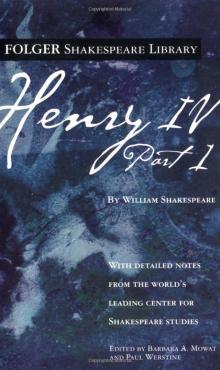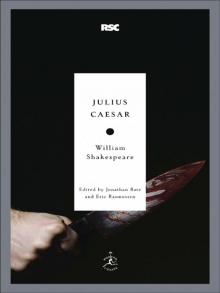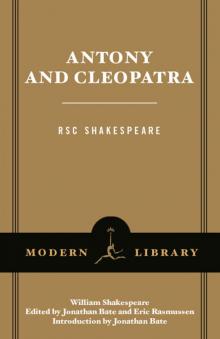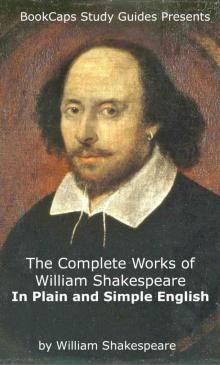- Home
- William Shakespeare
The Arden Shakespeare Complete Works Page 4
The Arden Shakespeare Complete Works Read online
Page 4
Elizabethan playwrights worked in a repertory system which constantly demanded new plays. Their natural expedient, encouraged by a literary climate which set store by creative imitation of existing models, was to base many, even most, of their plays on familiar stories. Shakespeare was no exception, other than in the range of subjects he dramatized. Almost all his plays can be shown to follow, broadly or closely, what scholars have designated as his ‘sources’ – that is, earlier texts he had read or otherwise knew of. Often he combined material from two or more sources into a single play, particularly in his comedies. His reading was wide and multifarious: history – Greek, Roman and English; prose fiction (chiefly translated into English from continental originals); earlier plays, ancient and modern, in Latin, Italian and English; pamphlets and other ephemera – all were grist to his mill. He had favourite authors, such as Chaucer, Spenser and Sir Philip Sidney among English writers, or Montaigne, whose essays he seems to have known by the time he wrote Hamlet (about 1600). His Latin favourites were Ovid’s Metamorphoses and the comedies of Plautus, but he also knew Virgil, Seneca and Horace, and Plutarch’s Lives of the Noble Grecians and Romans, written originally in Greek, were well known to him in Thomas North’s English translation. Playwrights of his own and the previous generation, notably John Lyly, Thomas Kyd, Robert Greene and Christopher Marlowe, had much to offer him by way of example, and he must also have learned from his interaction with such rivals as Ben Jonson and from his collaborators, John Fletcher and (less certainly) Thomas Middleton. In addition he was, as an actor, deeply immersed in the repertoires of his successive companies.
Reading Shakespeare four hundred years later, we encounter the English language of a period now described as Early Modern, before any notion of correctness of usage, whether of grammar, syntax, spelling or punctuation, had acquired wide currency, let alone authority. The primary language of education, both in schools and universities, was still Latin, a language which required the formal understanding of its rules and structures. Shakespeare had his own schooling in Latin, a schooling which included the standard subjects of grammar, logic and (most important of the three for an aspiring poet) rhetoric, the art of appropriate use of language for all practical and literary purposes. The fluidity of English in the late sixteenth century was a gift to a linguistically inventive generation of writers. Shakespeare did as much as any to exploit and extend the wide range of literary styles and linguistic registers available to him. His characters speak in all styles, from the artificial rhyming verse of Love’s Labour’s Lost or Romeo and Juliet to the uneducated prose of Dogberry or the regional dialect of Fluellen. It was to his plays that Samuel Johnson turned, while compiling his great Dictionary (1755), for illustrations of ‘the diction of common life’.
Blank verse, already the norm of dramatic language in the 1580s, was adopted by Shakespeare and developed into the flexible and versatile medium of his Jacobean plays. The forging of a dramatic prose which could range from low comedy to Hamlet’s philosophical musings or the inexhaustible improvisations of Falstaff was among his major stylistic achievements. The conciseness which is so marked a feature of his dramatic writing was learned, in part, from the experience of writing sonnets.
Readers of Shakespeare have long needed the assistance of a glossary to help with the unfamiliar vocabulary or idiom and the semantic changes which constitute one initial obstacle to full enjoyment and understanding. The glossary in this volume is based on the commentaries in the Arden editions whose texts are reprinted in it. It aims at giving answers to readers’ most likely questions but makes no attempt at full explanation of the sources of difficulty. Readers should always remember that Shakespeare’s plays were written to be heard, not read – least of all silently read. The attempt at full understanding of linguistic detail and subtlety (if such an aim were attainable) should always be seen as secondary to the experience of the play as a whole. Fuller comprehension of detail will follow with subsequent rereadings.
AFTERLIFE
While ‘Shakespeare’ has been a stable element in English culture for four hundred years, and has been successfully exported to numerous other cultures, there is considerable variation in the reputation and influence of individual works. Each generation seems able to find something (its own image?) in ‘Shakespeare’, but it has always been possible to choose a different text or a different interpretation. Some plays, such as Julius Caesar, Romeo and Juliet and The Taming of the Shrew, have an almost continuous history of performance and appear regularly on school and college syllabuses; others, such as Timon of Athens, Troilus and Cressida and Pericles, are rarely either performed or set for study; others again, such as Cymbeline, King John and King Henry VIII, were far more popular in the past than they are today. During his lifetime it would seem that Shakespeare’s most highly esteemed tragedy was Titus Andronicus; for the next 350 years it was Hamlet; since about 1960 it has been King Lear. There is a similar degree of variation in the extent to which works have been adapted, translated and filmed. Broadly speaking, the ‘afterlife’ of the plays and poems has depended on and can be measured by four things: publication, performance, criticism, and adaptation and creative influence.
Publication
Publication is taken first as even performers need to read plays before they stage them. About half of Shakespeare’s plays were published during his lifetime as single pocketsize paperback volumes known from their method of printing and small size as Quartos. All the plays in the present volume apart from Pericles and The Two Noble Kinsmen were printed (or reprinted) after his death in the large-format 1623 First Folio. Until 1709 two separate traditions of publication continued independently of each other: the First Folio was followed by the Second (1632), Third (1663) and Fourth (1685) Folios – ‘literary’ collections of the almost-complete works which found their way into the libraries of individuals and institutions – while many of the Quartos were reprinted as play-texts, used by actors and bought by playgoers.
In 1709 Nicholas Rowe published The Works of Mr William Shakespear, Revised and Corrected in eight volumes, the first of a line of eighteenth-century edited texts. He based his text on the Folio but also began the tradition of including passages which had previously appeared only in the Quartos. He and later eighteenth-century editors also provided commentaries in which they often disagreed with each other over variant readings, emendations and interpretations. These editions were usually published by subscription and were relatively expensive, but cheap acting editions continued to be available, for example the rival sets published in the 1730s by Robert Walker and Jacob Tonson or Bell’s Shakespeare (1773-4). The nineteenth century saw the publication of cheaper mass-market texts and, after the Bowdlers’ Family Shakespeare (1807), a proliferation of expurgated texts explicitly aimed at women and children. In the twentieth century, Shakespeare continued to be big business for publishers and editors, with hot competition for school, college and university markets, and the consequent provision both of popular versions of Shakespeare and of increasingly specialist series such as Shakespeare in Performance, which provides detailed annotation of stage business, and Shakespearean Originals, which offers reprints of the earliest texts.
Image removed — rights not available
12 The three witches in the television cartoon version of Macbeth (1993)
Shakespeare has also, of course, been translated into many languages. Some translations have become ‘classics’ in their own right – François-Victor Hugo’s translations into French, August Wilhelm Schlegel’s translations into German, and Boris Pasternak’s translations into Russian – but it has also seemed necessary for each generation to produce new translations, just as each generation of English speakers produces new editions.
Performance
Our records of performances in Shakespeare’s lifetime are poor, possibly because of the fire which destroyed the first Globe Theatre (and presumably its papers) in 1613. The title-pages of play-texts sometimes give misleading info
rmation about whether plays were (or were not) performed and where; sometimes we have to rely on chance diary entries or on what we can deduce from passing references by contemporaries – evidence for pre-1623 performances is provided in the introductions to individual plays in this volume. We do know that the plays were not performed at all after 1642 when the theatres were closed during the Civil War and the Commonwealth period, but that they returned as staple fare when the theatres reopened at the Restoration of the monarchy in 1660. At this time Shakespeare was popular but not as popular as the Jacobean dramatists Beaumont and Fletcher. Two significant innovations in 1660 were the use of stage scenery and the introduction of female performers; before 1640 women’s roles had been played by boys.
The Restoration theatres were relatively small, indoor and expensive, attracting patrons from upper- and middle-class circles. In this they were like the Blackfriars Theatre, used by the King’s Men before the Civil War, and unlike the large outdoor Globe which had cheap standing room for those who could not afford a seat. Attendance at a Shakespearean performance had thus become more of a minority pursuit, though touring companies continued to flourish in the British provinces and abroad in the eighteenth and nineteenth and indeed twentieth centuries. Shakespeare reached a mass market again with the invention of film and video in the twentieth century. The versions performed in the Restoration and in the eighteenth century were regularly cut (partly in order to allow time for changing the scenery and trimming the candles) and often substantially rewritten. Despite a first attempt by the famous actor David Garrick in the mid-eighteenth century to restore more of Shakespeare’s lines, the performance tradition continued to give audiences far less of the texts than was available in published versions.
A fashion for historical accuracy and heavily pictorial staging in the nineteenth century further weighted the plays with unnecessary baggage, and it was not until the 1880s that, under the influence of William Poel, a serious attempt was made to return to fluid ‘Elizabethan’ staging with minimal props and scenery. In Britain in the twentieth century the performance of Shakespeare became institutionalized with the foundation of the Shakespeare Memorial Theatre (originally built 1879, rebuilt after a fire in 1932) and later, in 1961, of the Royal Shakespeare Company, which currently performs in three theatres in Stratford-upon-Avon and two in London and undertakes national and international tours.
Shakespeare’s plays were widely performed in Europe from the very beginning (English actors toured to Germany, Poland and other countries), and a strong acting tradition grew up in America in the nineteenth century, but the silent cinema brought a new and powerful means of internationalization. Dozens of silent versions were made, in America, England, Germany, France and Italy, usually abbreviating the plots but often finding inventive ways of replacing Shakespeare’s language with visual images. This tradition continued into the sound period after 1929 when, perhaps ironically, it has been precisely those films which have not been ‘hampered’ by Shakespeare’s text which have been seen as the most successful screen versions: Akira Kurosawa’s Japanese Macbeth (Throne of Blood, 1957), for example, and Grigori Kozintsev’s Russian Hamlet (1964) and King Lear (1970). A few English-language directors have nevertheless managed to make creditable films, notably Laurence Olivier (Henry V, 1944, Hamlet, 1948, Richard III, 1955), Orson Welles (Macbeth, 1948, Othello, 1952, Chimes at Midnight (the Falstaff plays), 1966) and Kenneth Branagh (Henry V, 1989, Much Ado About Nothing, 1993, Hamlet, 1996). Many Shakespeare films are commercially available on video; the British Broadcasting Company and the American Time-Life Corporation sponsored a series of the complete works for television from 1979 to 1985 which, while proving uneven aesthetically, has become an invaluable resource for those without access to live performances.
Criticism
The first person to publish a critical essay on Shakespeare was Margaret Cavendish, Duchess of Newcastle, in 1664. She was a poet, dramatist and essayist, and in effect inaugurated a tradition of critical writing on Shakespeare by people who were themselves creative writers: John Dryden, Samuel Johnson, William Hazlitt, Samuel Taylor Coleridge and T.S. Eliot are examples of such influential critics whose work is still read today. While from the beginning Shakespeare was highly praised for his dramatic skills, particularly in the construction of lifelike characters, late seventeenth- and eighteenth-century writers were often critical of what they saw as his grammatical incorrectness, his undisciplined elaboration of metaphors and his carelessness with plotting and historical accuracy. During the nineteenth century the general tone became more adulatory and the focus on character increased: many studies treated Shakespeare’s men and women as if they were real people or at least characters in realistic novels. The publication by famous performers of their reminiscences enhanced this tendency. At the same time, the introduction of English Literature as a subject for study at universities brought about a professionalization of criticism and resulted in the situation we have today where most Shakespeare criticism is written by people with full-time academic posts in university departments of English or Drama.
Image removed — rights not available
13 David Garrick in four of his most famous Shakespearean roles, from a contemporary engraving
Image removed — rights not available
14 Ellen Terry as Mistress Page in The Merry Wives of Windsor
Modern criticism is diverse and alarmingly prolific: the American journal Shakespeare Quarterly publishes listings which show that around two hundred items (editions, translations, books and essays) are currently published every year on King Lear, and around four hundred on Hamlet. As in the past, critics today aim in various ways to elucidate Shakespeare for audiences and readers. They study his language and the literary and dramatic conventions of his time. They explore the circumstances in which the texts were originally produced – how and where they were performed, how they were copied and printed. They are also perhaps more attentive than their predecessors were to the circumstances in which the texts are continually reproduced – how and why we keep rereading and even rewriting Shakespeare for our own purposes. Dominant in recent criticism are issues of power and gender: ‘power’ in the sense of Shakespeare’s relation to and analysis of early modern political structures and also in the sense of the power of ‘Shakespeare’ as a cultural artefact; ‘gender’ in the sense of his representations of gender identity and sexual relations when seen from the perspective of the continuing struggle of women, gay men and lesbians for acceptance and equality.
Image removed — rights not available
15 A modern production of A Midsummer Night’s Dream (Royal Shakespeare Company, 1994)
Adaptation and creative influence
While he was still alive, some of Shakespeare’s works were already exerting an influence on other writers. John Fletcher’s play The Woman’s Prize, or The Tamer Tamed (1611) is a ‘sequel’ to The Taming of the Shrew, and Fletcher and Francis Beaumont’s Philaster (1609) could not have been written without Hamlet; if we read the plays of the next generation of dramatists such as John Ford, Philip Massinger, Thomas Middleton and John Webster, we keep encountering echoes of Shakespeare in characters, situations, lines and phrases. In the Restoration period playwrights ‘adapted’ his plays for their own stage by cutting them and ‘improving’ the language, correcting Shakespeare’s grammar and clarifying his difficult metaphors. They also began to rewrite the plays substantially, producing hybrids which are clearly dependent on their Shakespearean originals but sometimes very different in their handling of the plots. John Dryden and William Davenant’s 1667 The Enchanted Island, for example, a version of The Tempest, introduces a sister for Miranda and Hippolito, a man who has never seen a woman; Dryden’s 1678 All for Love is a version of Antony and Cleopatra in which Antony’s wife Octavia confronts Cleopatra (who never wavers in her commitment to Antony); Nahum Tate’s 1681 King Lear leaves Lear and Gloucester alive at the end and Cordelia about to marry Edgar.
I
n later centuries, the plays inspired works in other genres: operas, novels, films and musicals. Neither Henry Purcell’s opera The Fairy Queen (1692) nor Benjamin Britten’s opera (1960) would exist without A Midsummer Night’s Dream; Hamlet inspired countless works in the nineteenth century from Johann Wolfgang von Goethe’s novel Wilhelm Meister’s Apprenticeship (1795) and Charles Dickens’s Great Expectations (1860-1) to Anton Chekhov’s play The Seagull (1896); such musicals as Cole Porter’s Kiss Me Kate (1948) and Jerome Robbins’s and Leonard Bernstein’s West Side Story (1957) depend on The Taming of the Shrew and Romeo and Juliet respectively. In recent times King Lear has inspired Akira Kurosawa’s film Ran (1984) and Jane Smiley’s novel A Thousand Acres (1991); The Tempest has inspired Suniti Namjoshi’s poem sequence Snapshots of Caliban (1984) and Marina Warner’s novel Indigo (1992).
Image removed — rights not available
16 (above) Sir Henry Beerbohm Tree in the surviving silent film fragment of King John, 1899
Image removed — rights not available
17 (right) Laurence Olivier as the King in the 1944 film of Henry V
Image removed — rights not available
18 (below) Akira Kurosawa’s Japanese film version of Macbeth, Throne of Blood, 1957
Shakespeare’s fame and influence began early and show no sign of abating. In the volume of his notebooks covering the years 1661-3, John Ward, vicar of Stratford-upon-Avon from 1662 to 1681, wrote of his most famous deceased parishioner:
I have heard that Mr. Shakespeare was a natural wit, without any art at all; he frequented the plays all his younger time, but in his elder days lived at Stratford, and supplied the stage with 2 plays every year, and for that had an allowance so large, that he spent at the rate of a thousand pounds a year, as I have heard.

 Romeo and Juliet
Romeo and Juliet As You Like It (Folger Shakespeare Library)
As You Like It (Folger Shakespeare Library) Hamlet
Hamlet Richard II (Folger Shakespeare Library)
Richard II (Folger Shakespeare Library) Macbeth
Macbeth Henry V
Henry V The Winter's Tale
The Winter's Tale The Taming of the Shrew
The Taming of the Shrew The Comedy of Errors
The Comedy of Errors King Lear (Folger Shakespeare Library)
King Lear (Folger Shakespeare Library) Twelfth Night
Twelfth Night Othello
Othello The Two Gentlemen of Verona
The Two Gentlemen of Verona Henry IV, Part 1 (Folger Shakespeare Library)
Henry IV, Part 1 (Folger Shakespeare Library) King John/Henry VIII (Signet Classics)
King John/Henry VIII (Signet Classics) The Tempest
The Tempest Titus Andronicus (Dover Publications)
Titus Andronicus (Dover Publications) A Midsummer Night's Dream
A Midsummer Night's Dream Antony and Cleopatra (Arden Shakespeare: Third Series)
Antony and Cleopatra (Arden Shakespeare: Third Series) The Oxford Shakespeare: Henry IV, Part 2 (Oxford World's Classics)
The Oxford Shakespeare: Henry IV, Part 2 (Oxford World's Classics) Much Ado About Nothing (Arden Shakespeare: Third Series)
Much Ado About Nothing (Arden Shakespeare: Third Series) All's Well That Ends Well
All's Well That Ends Well Titus Andronicus & Timon of Athens
Titus Andronicus & Timon of Athens Richard III (Modern Library Classics)
Richard III (Modern Library Classics) Coriolanus
Coriolanus srsly Hamlet (OMG Shakespeare)
srsly Hamlet (OMG Shakespeare) The Merchant of Venice
The Merchant of Venice Richard III
Richard III Richard II
Richard II Pericles
Pericles As You Like It
As You Like It Cymbeline
Cymbeline Alls Wel that ends Well
Alls Wel that ends Well YOLO Juliet
YOLO Juliet A Midsummer Night #nofilter
A Midsummer Night #nofilter Love's Labour's Lost
Love's Labour's Lost Much Ado About Nothing
Much Ado About Nothing Romeo & Juliet & Vampires
Romeo & Juliet & Vampires The Arden Shakespeare Complete Works
The Arden Shakespeare Complete Works Julius Caesar
Julius Caesar Five Revenge Tragedies: The Spanish Tragedy, Hamlet, Antonio's Revenge, The Tragedy of Hoffman, The Revenger's Tragedy (Penguin Classics)
Five Revenge Tragedies: The Spanish Tragedy, Hamlet, Antonio's Revenge, The Tragedy of Hoffman, The Revenger's Tragedy (Penguin Classics) Macbeth #killingit
Macbeth #killingit The Oxford Shakespeare: The Complete Works
The Oxford Shakespeare: The Complete Works Hamlet, Prince of Denmark (Collins edition)
Hamlet, Prince of Denmark (Collins edition) King John & Henry VIII
King John & Henry VIII Henry IV, Part 2
Henry IV, Part 2 Complete Plays, The
Complete Plays, The The Sonnets and Other Poems
The Sonnets and Other Poems Antony and Cleopatra
Antony and Cleopatra Henry IV, Part 1
Henry IV, Part 1 Is This a Dagger Which I See Before Me?
Is This a Dagger Which I See Before Me? The Complete Works of William Shakespeare In Plain and Simple English (Translated)
The Complete Works of William Shakespeare In Plain and Simple English (Translated) The Sonnets
The Sonnets